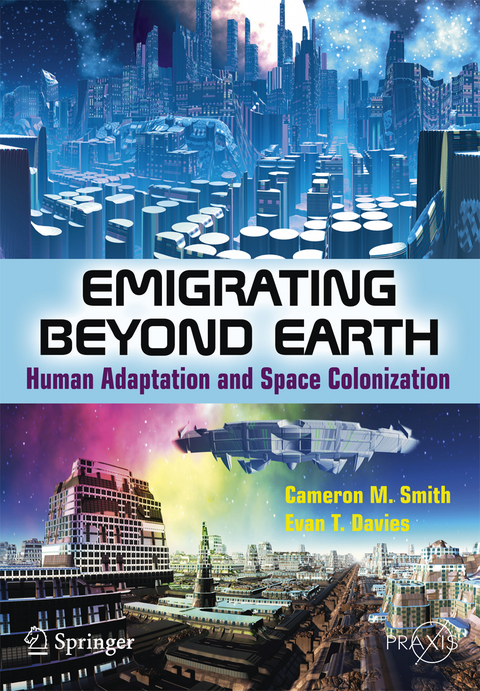
Emigrating Beyond Earth
Springer-Verlag New York Inc.
978-1-4614-1164-2 (ISBN)
Emigrating Beyond Earth puts space colonization into the context of human evolution. Rather than focusing on the technologies and strategies needed to colonize space, the authors examine the human and societal reasons for space colonization. They make space colonization seems like a natural step by demonstrating that if will continue the human species' 4 million-year-old legacy of adaptation to difficult new environments. The authors present many examples from the history of human expansion into new environments, including two amazing tales of human colonization - the prehistoric settlement of the upper Arctic around 5,000 years ago and the colonization of the Pacific islands around 3,000 years ago - which show that space exploration is no more about rockets and robots that Arctic exploration was about boating!
Dr. Cameron M. Smith, Ph.D., teaches human evolution and prehistory at the Department of Anthropology at Portland State University in Oregon. His professional training began as a student of Harvard University's early human archaeology field school at the Leakey research station in northern Kenya. After a year at the University of London's Institite of Archaeology, Dr. Smith earned a Joint Honors BA in Anthropology and Archaeology at Durham University before completing graduate degrees in the US and Canada. His courses emphasize adaptation and evolution as structuring factors of human prehistory. Dr. Smith has been widely published in both scientific journals and popular science magazines, including the American Journal of Physical Anthropology, Structure and Dynamics, the Journal of Field Archaeology, Scientific American MIND, Scientific American, Evolution: Education and Outreach, Archaeology, Hang Gliding and Paragliding and Spaceflight. He has written about evolution book and magazines including The Top Ten Myths About Evolution (Prometheus, 2006) endorsed by the National Center for Science Education and the American Library Association, and The Fact of Evolution (Prometheus, 2011) endorsed by Science Daily and recently picked for the Scientific American Book Club. Away from his office, Dr.Smith is an active Scuba diver and paraglider pilot. He is a fellow of both the Royal Geographical Society and the Explorers Club of New York. Evan T. Davies, Ph.D., began his academic training in archaeology at Cornell University and has conducted fieldwork throughout the United States, Europe, sub-Saharan Africa and the South Pacific. He completed his graduate studies in cultural anthropology at Rice University, where he focused on land use among traditional hunter-gatherer societies in Central Africa. He serves as a defense attache, African area expert and imagery scientist in the United StatesNavy. In 2007 while deployed on a combat tour with the multi-national forces in Iraq, Dr. Davies became involved with efforts to preserve Iraqi antiquities and archaeological sites. His experiences in Iraq led him to pursue medical studies and in the coming years he intends to work in wilderness and expedition medicine as well as continue anthropological research into indigenous pharmaceuticals and healing practices. Dr. Davies is a fellow of both the Royal Geographical Society and the Explorers Club of New York and his popular science writing has appeared in Wiley publications as well as Spaceflight and Archaeology magazines. He has a held a lifelong interest in space exploration.
List of Figures.- List of Tables.- Acknowledgements and Dedications.- About the Authors.- Preface.- Part I: The Context and Uniqueness of Human Evolution and Adaptation.- Chapter 1: The Extraterrestrial Adaptation: Humanity, Evolution and Migration Into Space.- Chapter 2: Stardust: The Origins of Life, Evolution and Adaptation.- Chapter 3: The Adaptive Equipment of the Genus Homo: Symbolism and Niche Construction.- Part II: Arguments For and Against Human Space Colonization.- Chapter 4: A Choice of Catastrophes - Common Arguments for Space Colonization.- Chapter 5: False Choices - Common Objections to Human Space Colonization.- Part III: Human Adaptation to Space - Lessons from the Past and Shaping the Future.- Chapter 6: Starpaths - Adaptation to Oceania.- Chapter 7: Building an Adaptive Framework for Human Future in Space.- Bibliography.- Index.
| Erscheint lt. Verlag | 12.6.2012 |
|---|---|
| Reihe/Serie | Popular Science | Springer Praxis Books |
| Zusatzinfo | 45 Illustrations, black and white; XXIII, 290 p. 45 illus. |
| Verlagsort | New York, NY |
| Sprache | englisch |
| Maße | 168 x 240 mm |
| Themenwelt | Sachbuch/Ratgeber ► Natur / Technik ► Weltraum / Astronomie |
| Naturwissenschaften ► Geowissenschaften ► Geografie / Kartografie | |
| Naturwissenschaften ► Physik / Astronomie ► Angewandte Physik | |
| Naturwissenschaften ► Physik / Astronomie ► Astronomie / Astrophysik | |
| Technik ► Luft- / Raumfahrttechnik | |
| Schlagworte | Adaptive radiations • Extraterrestrial adaptation • Human space colonization • space colonization • space exploration |
| ISBN-10 | 1-4614-1164-5 / 1461411645 |
| ISBN-13 | 978-1-4614-1164-2 / 9781461411642 |
| Zustand | Neuware |
| Haben Sie eine Frage zum Produkt? |
aus dem Bereich


